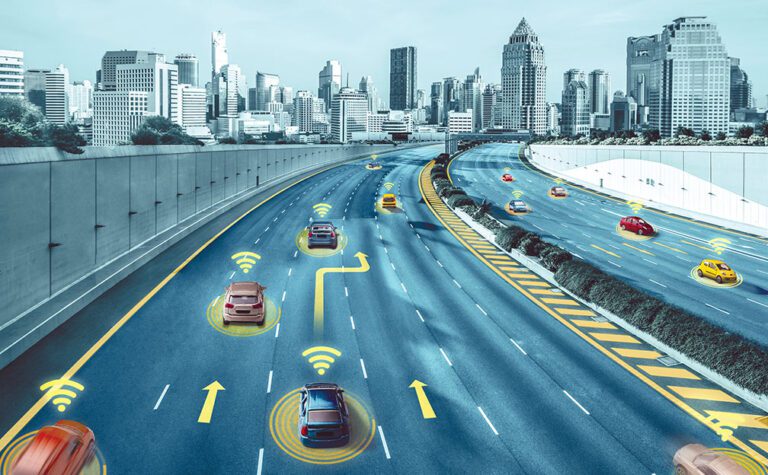As the trucking industry continues its march toward autonomy, it benefits from nearly every advance in technology taken by the developers. Products that could one day help bring about driverless freight transport are already helping carriers ensure that their drivers are as safe possible on the road.
Some advanced driver-assistance systems (ADAS) are now standard on newer commercial vehicles, with improved versions being released and implemented frequently.
When electronic control modules (ECUs) were incorporated into truck engines in the 1980s, the door to autonomy opened wide. Onboard diagnostics became possible. Advances in telemetry brought information to the home terminal long before the truck arrived. Early ADAS technology focused on warning the driver when a hazard was detected. Blind-spot monitors, along with lane-departure warnings and collision alerts evolved. Adaptive cruise control, stability control, lane-keeping assist and automatic emergency braking are now available on most trucks, and are standard on some models.
Video technology has also evolved, from devices that allow carriers to see and record the view from the windshield to systems that record the area around the vehicle and inside the cab. In the latest evolution, artificial intelligence (AI) is being used by some vendors to identify which triggered events require review as well as identifying other events that don’t correspond to triggers, such as running a red light.
These advances, however, come at a cost. New truck prices, maintenance costs, recruiting and training costs are all on the rise, and insurance rates have climbed steadily. The payback, of course, is in the performance of both the equipment and the driver.
Is safety technology worth the price?
In a September 2021 webinar jointly presented by the Federal Motor Carrier Safety Administration’s (FMCSA) “Tech-Celerate Now” program and Partners for Automated Vehicle Education (PAVE), Cargo Transporters vice president of safety Shawn Brown had this answer: “The real ROI is what it keeps you out of. It keeps you out of court; it keeps you out of paying settlements.”
Andre Durocher, director of security and risk management with Lachine, Quebec-based Logistiques Trans-West, agreed.
“I like to say, as a joke, that in the (United) States the national sport is not baseball, it’s suing,” he said. “So, trucking companies have to look ahead and, in an eventual trial, explain why we are using or not using such technology.”
Use of safety technology alone, however, isn’t enough to achieve desired results.
“The proactive carrier has found that employing this technology is not a scenario in which we could describe as a ‘set it and forget it,’” explained David Heller, senior vice president of safety and government affairs for the Truckload Carriers Association. “Carriers who employ this technology do so knowing that the uses go further than just a sound defensive position during litigation but also as an opportunity to coach their drivers to perform at a safer level.”
Even without litigation, accidents drive up insurance and maintenance costs and impact retention and recruiting of new drivers. Customers are often concerned with carriers’ safety records, including CSA (compliance, safety, and accountability) scores, and when accidents occur, can be held liable for shipping with carriers that have poor safety records.
During the FMCSA/PAVE webinar, Dean Newell, vice president of safety and driver training for Arkansas-based Maverick Transportation, said of the effectiveness of safety tech: “We believe in it; it’s our culture. We’ve been successful with it. Our stats prove that things are going in the right direction. We believe in the technology.”
Another vote for safety tech came from Michael Lasko, director of EHS (environment, health, and safety) and quality for Boyle Transportation, a company he describes as an “early adopter” of ADAS.
“These technologies have absolutely made an impact,” Lasko remarked. “We have achieved impressive results using a combination of hiring the right people, and deployment of technologies.”
Durocher said that Trans-West tends to use “the latest equipment out there,” but cautioned that the amount of data collected by safety systems can be overwhelming.
“I find that the greatest challenge is probably to choose what you’re going to use and why you’re going to use it,” he said. “Because otherwise I find that you almost need an army of people to check out the information.”
A 40-year veteran of law-enforcement, Durocher also notes that it’s important to understand how the data applies to different situations.
“If a driver has, for example hard brakes at a certain rate, is he at risk more?” he asked. “If he is, let us correct those things before (an accident) happens.”
Before intervention, says, more analysis might be needed.
“When I started in the business, I was looking at some drivers and I said, ‘My God, they’ve got a lot of hard brakes,” he shared, adding that it turned out that unsafe driving wasn’t the sole culprit.
“We have two types of drivers — drivers that do the long hauls like to California, and we also have what we call city drivers,” he said, explaining that analysis of the data revealed which group had more hard-braking events. “They’re the city drivers who fight traffic constantly.”
In-cab video recording devices have been widely accepted by the industry and by drivers … as long as the cameras are forward-facing. Drivers’ concerns about privacy, as well as regulations in some jurisdictions, have slowed sales of driver-facing units.
The support that comes with the camera, such as video availability, is often more important to buyers than camera quality.
Several vendors use AI to review driving actions, and some even determine whether to forward a video to carrier representatives. These AI systems can identify when events such as hard braking or swerving were justifiable based on traffic conditions — for example, if another vehicle suddenly changed lanes in front of the truck. They can also identify events that aren’t triggered by driving actions, such as driver fatigue or cellphone use.
These systems can help carriers decipher the information collected and reduce the staff needed to review it. Some also offer standardized post-event driver training modules.
As long as drivers are still necessary, the technology that helps keep everyone safe will continue to evolve.
“The bottom line is that the positive improvements to their driver safety performances will ultimately affect a carrier’s accident ratio and ensure that their freight can be delivered in a timely and safe manner,” Heller said.
This article originally appeared in the May/June 2023 edition of Truckload Authority, the official publication of the Truckload Carriers Association.
Cliff Abbott is an experienced commercial vehicle driver and owner-operator who still holds a CDL in his home state of Alabama. In nearly 40 years in trucking, he’s been an instructor and trainer and has managed safety and recruiting operations for several carriers. Having never lost his love of the road, Cliff has written a book and hundreds of songs and has been writing for The Trucker for more than a decade.














